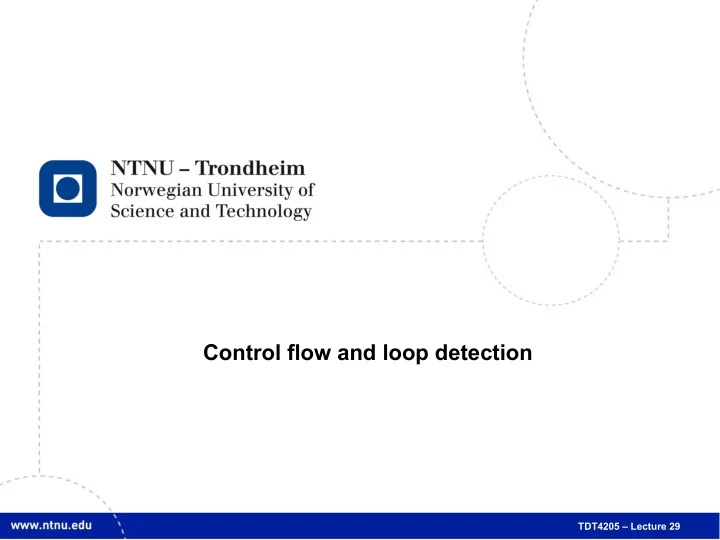

1 Control flow and loop detection TDT4205 – Lecture 29
2 Where we are • We have a handful of different analysis instances • None of them are optimizations, in and of themselves • The objective now is to – Show how loop detection is a simple instance of the same ideas – Suggest how a combination of different analysis results enable a loop optimization (loop-invariant code motion)
3 Detecting loops • It’s easy to detect loops at the syntactic level – Unless there are free-form jump instructions in the language, loops are explicitly written in the source code • It’s not as easy to detect loops at lower levels – Low-level code has only jump instructions – General control flow graphs have only edges • Language-independent optimizations need to elucidate loops implicit in the control flow
4 Control flow analysis In a Control Flow Graph, • A loop is a set of blocks that should be grouped together • There is a loop header every control flow that enters the loop must go through • There is a back edge from one of the blocks that leads back to the header header body body body body
5 Dominator relation • Introduce the idea that a node X dominates a node Y if every path to Y must go through X • Every node dominates itself 1 • 1 dominates 1,2,3,4 • Neither 2 nor 3 dominate 4 2 3 (There are paths to 4 which bypass them) 4
6 Immediate dominators • The first node in a CFG dominates all the other ones – That’s not so useful to know • If both A and B dominate C, then either A dominates B, or B dominates A • A strictly dominates B if they’re separate (A != B) • The immediate dominator of a node n is the last strict dominator on any path to n – There can only be one – If there were multiple last strict dominators, they would not be dominators
7 Dominator tree • Dominators form a hierarchy, so we can represent them as a tree – The root is the entry node – Children attach to their immediate dominator 1 1 2 2 3 4 3 4 5 7 5 6 6 7
8 Control flow as a set of things This can be seen as a data flow problem: • dom(n) = set of nodes that dominate n • dom(n) = ∩ { dom(m) | m pred(n) } {n} ∊ ∪ • That is: dominators of n are the dominators of n-s predecessors, as well as n itself
9 Control flow as a DF problem Collecting sets of CFG nodes as the problem domain, we have the makings of another framework instance: • out[B] = in[B] U B • in[B] = ∩ { out[B’] | B’ ∊ pred(B) } • Transfer function is – Monotonic – Distributive – Practically trivial, all it represents is a collection of predecessors
10 Natural loops • A back edge is an edge where a node has a successor which dominates it • A natural loop has a back edge n→h such that – h is the loop header – nodes that can reach n without going through h are the loop body • To detect natural loops – Compute the dominator relation – Find back edges (use the dominator relation) – Find the loop body (predecessors of n that are dominated by h) • Starting with a back edge from n, traverse its predecessors until reaching h
11 Combine loops with shared header • Unstructured jumps, one can make multiple loops with the same header h L1 L2 • These can be combined h L1 L2 • This leaves only disjoint and nested loops
12 Preheader insertion • If an optimization needs to add code before the header, insert another basic block h h L1 L2 L1 L2
13 ...and now, an application (finally!) • Optimizations can combine the results of several analyses • Loop invariant code motion aims to find statements that produce the same result in every iteration, and move it outside of the loop for ( i=0; i<n; i++ ) buffer[i] = 10*i + x*x; might as well be tmp = x*x for (i=0; i<n; i++ ) buffer[i] = 10*i + tmp;
14 Identifying invariant code • An instruction a = b OP c is loop-invariant if – b and c are constants, or – all definitions of b and c are outside the loop, or – b and c are defined once, and their defs are loop-invariant • The invariant property for an instruction can be derived from – Finding that it’s inside a loop (using the dominator relation) – Finding the definitions that reach it (using reaching defs)
15 Moving invariant code • Introduce a pre-header and move a = b OP c there if – The definition a = b OP c dominates every loop exit where a is live • Search nodes dominated by this one, consult live variables – There is no other definition of a in the loop • Consult dominators for loop body, scan them for definitions of a – Every use of a in the loop can only be reached by this def. • Consult reaching definitions at every use of a, to see if there are others than this one which can influence it
Recommend
More recommend